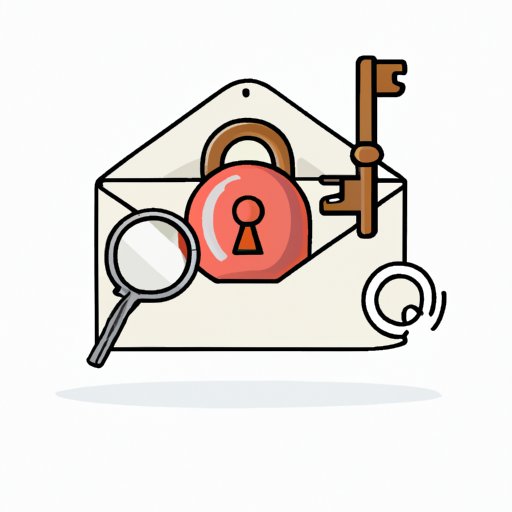
I. Introduction
In today’s digital age, data privacy and security are of the utmost importance. Email communications contain sensitive information that must be protected from cyber threats and various forms of attacks. Sending encrypted emails is an effective way to safe-guard your emails and communications from prying eyes and cybercriminals. This beginner’s guide to sending encrypted emails will provide you with everything you need to know!
II. Safeguarding your Communications: A Beginner’s Guide to Encrypted Emails
Encrypted emails are emails that have been encrypted, which means that the content is converted into a secret code that can only be read by those who have the decryption key or password. Encryption helps to protect the privacy and confidentiality of the email’s content and prevent unauthorized access to emails and sensitive information.
The encryption process involves a complex algorithm to scramble the content of the email. The recipient then can only read the message after inputting the correct password or decryption key. This process ensures that only the intended recipient can read the email.
There are different types of encryption, including asymmetric encryption, symmetric encryption, and end-to-end encryption. All of them help secure the email communication and protect against unauthorized access.
III. The Importance of Sending Encrypted Emails and How to Do It
Sending unencrypted emails can pose significant risks and security threats. Unencrypted messages can be intercepted and read by cybercriminals. Email hijacking and phishing attacks are common tactics among cybercriminals for stealing sensitive information, such as login credentials and personal data.
Sending encrypted emails offers a host of benefits, including enhanced privacy and confidentiality, data security, and authentication. The message content is kept confidential and only the intended recipient has access to the information.
To send encrypted emails, different email clients offer various encryption options. Most email clients offer built-in encryption options, but you must understand how to use them. For instance, Gmail offers two options, S/MIME and PGP, for encrypting your emails.
You can encrypt attachments by using password-protected ZIP files and password-protecting your important PDF files to further safeguard sensitive information.
IV. Email Security: 7 Simple Tips to Encrypt Your Messages
Here are some tips for securing your email account:
- Use strong passwords and two-factor authentication to prevent password hijacking.
- Use encrypted messaging apps like Signal and WhatsApp for secure communication.
- Install security and privacy plugins and extensions, such as Signal and Privacy Badger, to prevent unauthorized tracking and snooping.
- Avoid opening unknown links or attachments in the emails.
- Use a virtual private network (VPN) when using public Wi-Fi to browse the internet or send emails.
- Use anti-virus and anti-malware software to protect your system from malicious software.
- Encrypt your emails and attachments to send and receive confidential information securely.
V. The Ins and Outs of Encrypted Emails: A Step-by-Step Guide
Here is a step-by-step guide on how to send encrypted emails with a popular email client:
- First, open your email client.
- Compose a new message.
- Locate the security options for your email client.
- Choose the encryption option you prefer.
- Encrypt your email message.
- Input your recipient’s email address.
- Send your encrypted email.
Note that some email clients may have different settings or options for encrypting emails. Check with your email provider or see their help center for more guidance.
VI. Maximizing Privacy: Top 7 Ways to Send Encrypted Emails
To maximize email privacy, here are some additional tips:
- Use a trusted email encryption service, such as ProtonMail or Tutanota, for enhanced security.
- Encrypt your email attachments and files before sending them out.
- Use end-to-end encryption services for secure communication.
- Do not include any sensitive information in the subject line of your email.
- Only open emails from verified and trustworthy sources.
- Do not share your encryption keys or passwords with others. Change your passwords frequently to avoid hacking attempts.
- Keep your email client, software, and plugins updated to avoid security vulnerabilities and attacks.
VII. 7 Steps to Secure Your Emails with End-to-End Encryption
End-to-end encryption is a technique that encrypts the entire communication, including message content, metadata, and attachments. The recipient can only read the message after inputting the correct decryption key, which is known only to the sender and recipient. Here’s how to use end-to-end encryption:
- Choose an email client that supports end-to-end encryption. ProtonMail and Tutanota are examples.
- Create an end-to-end encrypted email account.
- Compose a message as you would with any other email.
- Encrypt your email by selecting the encryption option provided by your email client.
- Send your end-to-end encrypted email.
- The recipient will receive a notification that they have received an end-to-end encrypted message that needs to be decrypted.
- The recipient can then input the decryption key to read the message contents.
VIII. How to Send Encrypted Emails: A Comprehensive Tutorial for All Users
To summarize the guide, sending encrypted emails is an effective way to keep your communications private and safeguard sensitive information from cybercriminals. Different email clients offer various types of encryption options, and it is essential to know how to use them to secure your emails fully.
To send encrypted emails with a few popular email clients:
- Choose your preferred email client and open a new email.
- Select your encryption option under the email’s security settings or advanced options.
- Enter your message and attach files, if necessary.
- Encrypt the message and send the email to the intended recipient.
Additionally, encrypting your attachments using password-protected zip files and files that are password-protected in PDF format can offer added protection, enhancing the security of your encrypted emails and communications.
IX. Conclusion
Sending encrypted emails is crucial to guaranteeing the privacy and confidentiality of your email communications. This guide offers tips and step-by-step instructions for enhancing email security and navigating the various encryption options available with different email clients.





